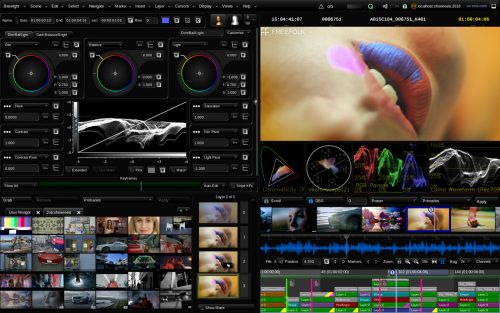Popular and proven grading software platform from FilmLight celebrates success by adding even more functionality for future-proof workflows
“Baselight 5 feels like brand new software, improving on foundation features that merge a whole new level of incredible technical precision and control with fantastic tools”. That’s the view of Matt Watson, DI Colorist at SHED London. And there will be even more for colorists and creatives to enthuse over at NAB2018 (Las Vegas Convention Center, 9–12 April, booth SL4310), where FilmLight will be demonstrating the new functionality recently added to their market-leading grading platform.
Central to Baselight 5 is the Base Grade, used extensively on recent blockbuster movies and TV series. This has proven to be an invaluable productivity tool for many. “We’ve used Baselight 5 for several features, including the Netflix Original Mercury 13,” said Matthew Troughton, Senior Colorist and Head of Picture Technology at Creativity Media in London. “Base Grade has become a go-to feature for me. I can retain overall contrast while easily being able to shake out detail in the bottom end, a task that previously required keys. It’s quick and easy, and means I can spend more time creating.”

As HDR technology evolves, Baselight colorists increasingly work with HDR acquisition and delivery for movies and premium TV projects, like the recent Black Panther or BBC’s Blue Planet II. Base Grade already takes the sting out of moving between different delivery formats, and between SDR and HDR, but FilmLight has developed more revolutionary tools that give colorists the right controls to ease the transition: Boost Range and an HDR-ready Looks operator.
Boost Range expands the dynamic range of an image when converting from SDR to HDR, using a local tone mapping approach. This results in more natural looking results, with more faithful contrast reproduction. The algorithm also eliminates issues with noise in the extended highlights and makes the whole ‘up-conversion’ more robust while achieving greater dynamic range.
The Looks operator has been upgraded for HDR to bring preferred color rendition to digital image pipelines. The new HDR options add the artistic tweaks to the pipeline to produce a cinematic look, while still maintaining the highest possible image quality when producing all deliverables – from SDR to HDR.
“The new looks are extremely helpful,” said Fernando Rodrigues, Senior Colorist at Filmmore in Amsterdam. “I was amazed by how easily I could re-obtain details that, at first glance, seemed to be clipped or crushed. The best thing is that they give a nice ‘thickness’ to the image, something a lot of my clients are looking for. The effect is very film-like.”
Munich-based DoP, Matthias Fleischer, agreed. “The Looks feature produces very cinematic roll-offs, and it creates lovely skin tones. When working with dailies, it actually feels a lot like dealing with scanned film footage.”
New functionality to be introduced at NAB includes support for 360/VR, so that virtually any tool in the Baselight arsenal – including secondaries, Paint and Perspective – can be used to grade 360 footage by operating in a ‘sandwich’ of two Panorama operators, which convert from LatLong (or equirectangular) projections to normal projection and back. LatLong projections are also supported in Baselight’s powerful format system, and LatLong images with traditional perspective can be viewed via a new toggle in the Cursor View.
The Relight tool has been boosted too, with support for area lights so you can add and adjust specular highlights to make more realistic lighting changes. Relight allows you to control the location of lights and specular highlights precisely by directly clicking in the image viewer.
The initial release of Baselight 5 provided many tools for VFX, including Grid Warp and the Perspective Tracker. “Perspective tracking went into immediate use and has proven extremely useful,” added Matthew Troughton. “It cuts to a fraction the manual work often associated with manually compensating and working around perspective windowing issues.”
In the latest version, the completely rewritten Text tool reduces the workload further in projects where Baselight is used for finishing as well as allowing for greater creativity. It brings Shape-like transform operations to text, so text objects can be manipulated with tools such as Perspective Transform, or tracked throughout a shot.
There are a host of other new features too, designed to enhance efficiency and improve workflows. This includes: strip locking to prevent accidental deletion; selecting strips by operator; searching for buttons and actions in Chalk; file trimming for R3D, Phantom, Sony XAVC and Sony RAW MXF files; a new Client View that shows the current frame and metadata; the ability to include the Shots Layout on the main image monitor, allowing a scrolling list of thumbnails to appear on the main display; and improvements to the Baselight keyers to provide more precise operation in wide gamut scene-referred color spaces.
The Baselight 5 software platform is applied to all of FilmLight’s color range. The full range of FilmLight systems will be demonstrated on booth SL4310 at NAB2018, including Daylight dailies and media management, Prelight on-set pre-visualisation, Baselight Editions and a number of Baselight configurations.



